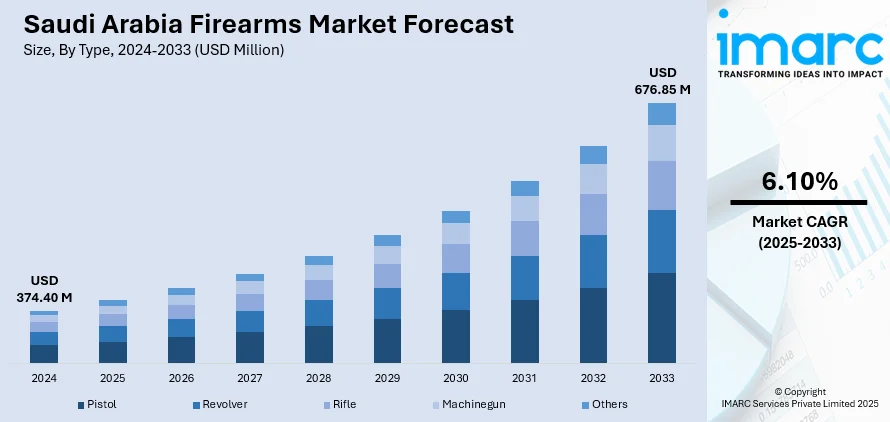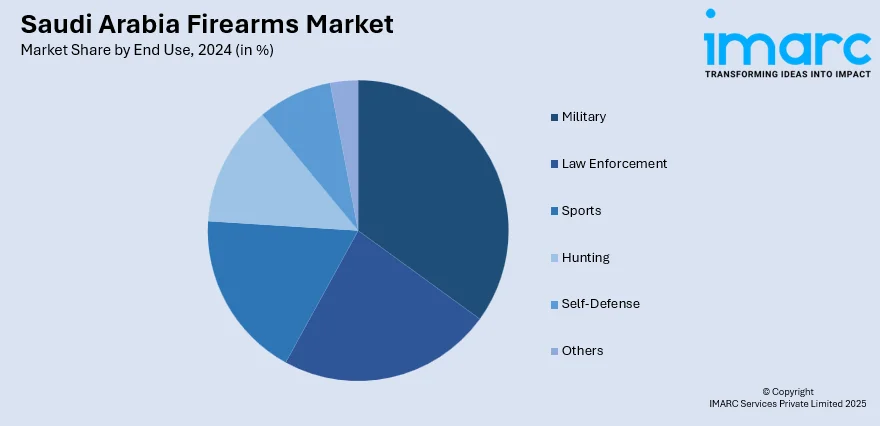
Saudi Arabia Firearms Market Size, Share, Trends and Forecast by Type, Technology, Operation, End Use, and Region, 2025-2033
Saudi Arabia Firearms Market Overview:
The Saudi Arabia firearms market size reached USD 374.40 Million in 2024. Looking forward, IMARC Group expects the market to reach USD 676.85 Million by 2033, exhibiting a growth rate (CAGR) of 6.10% during 2025-2033. The market is expanding due to rising defense modernization, increased local production initiatives, and strategic partnerships with global manufacturers. These trends are expected to boost Saudi Arabia firearms market share, driven by growing demand for advanced, fire-resistant, and precision-based weapon systems.
|
Report Attribute
|
Key Statistics
|
|---|---|
|
Base Year
|
2024 |
|
Forecast Years
|
2025-2033
|
|
Historical Years
|
2019-2024
|
| Market Size in 2024 | USD 374.40 Million |
| Market Forecast in 2033 | USD 676.85 Million |
| Market Growth Rate 2025-2033 | 6.10% |
Saudi Arabia Firearms Market Trends:
Growing Focus on Defense Modernization
Saudi Arabia's firearms market is witnessing a shift driven by major defense modernization efforts aimed at enhancing operational capability and strategic autonomy. The country has steadily moved toward integrating sophisticated systems across its military branches, increasing the demand for upgraded firearms and combat-ready platforms. This trend reflects the country’s aim to become less dependent on foreign military support by adopting high-precision and fire-resistant weaponry tailored to its defense needs. In May 2025, Saudi Arabia signed a landmark USD 142 Billion defense deal with the United States. This agreement included structured upgrades to Apache helicopters, armored ground units, and counter-drone systems—each involving advanced firearm systems and fire-resistant weapon platforms. These upgrades were part of a broader strategy to modernize air, land, and communication units while also incorporating cutting-edge electronics and secure networked combat systems. The inclusion of US defense majors such as Lockheed Martin, Boeing, RTX, and Palantir further indicated a long-term commitment to precision-focused warfare. The modernization drive is expected to directly influence procurement cycles for firearms, from tactical rifles to anti-armor munitions. This sustained investment has not only reinforced Saudi Arabia’s national defense posture but also created favorable conditions for private-sector participation and the long-term growth of the country’s firearms market.

Shifting Toward Localized Manufacturing
A strong shift toward domestic manufacturing is also shaping Saudi Arabia firearms market growth. The kingdom’s long-term strategy under Vision 2030 aims to localize half of its defense spending by building in-country production capacity. This trend is driven by the need for self-reliance, faster delivery timelines, and better control over supply chains for critical defense components, including fire-resistant firearms. In April 2025, Hanwha Aerospace entered advanced talks with Saudi authorities to develop arms production capacity within the country. The discussions covered options such as local facilities, joint ventures, and technology transfers, especially for systems suited to regional security challenges. The collaboration intends to support the development of fire-resistant defense platforms tailored for desert and high-temperature environments, which require specialized coatings and durable weapon systems. Localization will also enable the integration of region-specific operational feedback into firearm design and performance, enhancing battlefield efficiency. Over time, this approach is expected to create skilled employment, reduce dependence on imports, and attract international defense firms to invest in Saudi Arabia. The push for local arms production is not just a political or economic move—it is emerging as a core market driver that is fundamentally changing how firearms are developed, supplied, and maintained within the country.
Saudi Arabia Firearms Market Segmentation:
IMARC Group provides an analysis of the key trends in each segment of the market, along with forecasts at the country and regional level for 2025-2033. Our report has categorized the market based on type, technology, operation, and end use.
Type Insights:
- Pistol
- Revolver
- Rifle
- Machinegun
- Others
The report has provided a detailed breakup and analysis of the market based on the type. This includes pistol, revolver, rifle, machinegun, and others.
Technology Insights:
- Guided
- Unguided
A detailed breakup and analysis of the market based on the technology have also been provided in the report. This includes guided and unguided.
Operation Insights:
- Automatic
- Semi-Automatic
- Manual
The report has provided a detailed breakup and analysis of the market based on the operation. This includes automatic, semi-automatic, and manual.
End Use Insights:

- Military
- Law Enforcement
- Sports
- Hunting
- Self-Defense
- Others
A detailed breakup and analysis of the market based on the end use have also been provided in the report. This includes military, law enforcement, sports, hunting, self-defense, and others.
Regional Insights:
- Northern and Central Region
- Western Region
- Eastern Region
- Southern Region
The report has also provided a comprehensive analysis of all the major regional markets, which include Northern and Central region, Western region, Eastern region, and Southern region.
Competitive Landscape:
The market research report has also provided a comprehensive analysis of the competitive landscape. Competitive analysis such as market structure, key player positioning, top winning strategies, competitive dashboard, and company evaluation quadrant has been covered in the report. Also, detailed profiles of all major companies have been provided.
Saudi Arabia Firearms Market News:
- April 2025: Hanwha Aerospace entered advanced talks with Saudi Arabia to establish arms production capacity in the Middle East. The potential collaboration included joint ventures or facilities focused on fire-resistant defense systems, signaling a shift toward localized manufacturing and expanding Saudi Arabia’s firearms industry footprint.
- March 2025: Saudi Arabia approved a USD 100 Million purchase of 2,000 APKWS II guided rocket systems from the US. The deal included software, training, and logistics, strengthening precision strike capabilities and boosting demand for advanced, fire-resistant firearms in Saudi Arabia.
Saudi Arabia Firearms Market Report Coverage:
| Report Features | Details |
|---|---|
| Base Year of the Analysis | 2024 |
| Historical Period | 2019-2024 |
| Forecast Period | 2025-2033 |
| Units | Million USD |
| Scope of the Report |
Exploration of Historical Trends and Market Outlook, Industry Catalysts and Challenges, Segment-Wise Historical and Future Market Assessment:
|
| Types Covered | Pistol, Revolver, Rifle, Machinegun, Others |
| Technologies Covered | Guided, Unguided |
| Operations Covered | Automatic, Semi-Automatic, Manual |
| End Uses Covered | Military, Law Enforcement, Sports, Hunting, Self-Defense, Others |
| Regions Covered | Northern and Central Region, Western Region, Eastern Region, Southern Region |
| Customization Scope | 10% Free Customization |
| Post-Sale Analyst Support | 10-12 Weeks |
| Delivery Format | PDF and Excel through Email (We can also provide the editable version of the report in PPT/Word format on special request) |
Key Questions Answered in This Report:
- How has the Saudi Arabia firearms market performed so far and how will it perform in the coming years?
- What is the breakup of the Saudi Arabia firearms market on the basis of type?
- What is the breakup of the Saudi Arabia firearms market on the basis of technology?
- What is the breakup of the Saudi Arabia firearms market on the basis of operation?
- What is the breakup of the Saudi Arabia firearms market on the basis of end use?
- What is the breakup of the Saudi Arabia firearms market on the basis of region?
- What are the various stages in the value chain of the Saudi Arabia firearms market?
- What are the key driving factors and challenges in the Saudi Arabia firearms market?
- What is the structure of the Saudi Arabia firearms market and who are the key players?
- What is the degree of competition in the Saudi Arabia firearms market?
Key Benefits for Stakeholders:
- IMARC’s industry report offers a comprehensive quantitative analysis of various market segments, historical and current market trends, market forecasts, and dynamics of the Saudi Arabia firearms market from 2019-2033.
- The research report provides the latest information on the market drivers, challenges, and opportunities in the Saudi Arabia firearms market.
- Porter's five forces analysis assist stakeholders in assessing the impact of new entrants, competitive rivalry, supplier power, buyer power, and the threat of substitution. It helps stakeholders to analyze the level of competition within the Saudi Arabia firearms industry and its attractiveness.
- Competitive landscape allows stakeholders to understand their competitive environment and provides an insight into the current positions of key players in the market.
Need more help?
- Speak to our experienced analysts for insights on the current market scenarios.
- Include additional segments and countries to customize the report as per your requirement.
- Gain an unparalleled competitive advantage in your domain by understanding how to utilize the report and positively impacting your operations and revenue.
- For further assistance, please connect with our analysts.
 Request Customization
Request Customization
 Speak to an Analyst
Speak to an Analyst
 Request Brochure
Request Brochure
 Inquire Before Buying
Inquire Before Buying




.webp)




.webp)












